ARTIST & CREATIVE INTERVIEW SERIES,
Art/coffee, Salvager Kain, Gary Larson, elbowing Kathy Griffin and Paul Sloboda
I’m pretty happy about starting this artist interview series for various reasons. Mostly because it has very little to do with me and very much to do with the intriguing stories of OTHERS. As a creative I spend too much time in my own head and this interview just goes to show how great it is to occasionally escape and examine someone else’s inner workings for a change.
This first artist interview couldn’t be more perfect. Here’s a quick flash back to why. Back in junior high, eons ago, before hipsters roamed the earth I oft times rubbed elbows with some pretty awesome budding artists hoping to eventually be in the same league (or at least faking it in the mean time). We had all been thrown together in a new school for our junior year and things were new and shiny. During these years there was one particular stand out in the artsy crowd. The artist everyone secretly wanted to be like. He oozed creativity (whether he knew it or not). Today he’s still is one of the most genuinely creative, kind and humble humans I know. He’s come a long way from junior high with his creativity and endeavors and I can’t be more jazzed to present this interview with Paul Sloboda.

ARTIST INTERVIEW, Paul Sloboda, multi-disciplined artist.
shari: PAUL, WHEN DID YOU GET YOUR ARTISTIC START and why did you continue following a creative path? (Totally two questions but who’s counting?)
pslo: The first is endlessly debatable. My parents, especially my mom, encouraged my artistic talents over the years, but I wouldn’t say that necessarily amounts to an “artistic start”. It seems like equal credit could be given to summer sleepovers at my grandma’s house when I was 7 or 8, left with pens and paper and nothing but time. Plus she bought me my first comic book—Micronauts #11, in 1979 — so I think we should definitely give her props for that. It’s certainly a question I think about now that I have a young kid who I’d love to see get into creating art; should I let him be bored for an hour with nothing but pens and paper, or should I encourage and provoke creative ideas & expression? If you’re looking for the genesis of artistic temperament, I’d say “give ‘em love and felt markers and encourage lateral thinking”, but you get head start bonus points if they’re already a Pisces.
As for the other question, “why continue following a creative path”: I kind of believe it’s just something you do. One way to put it is, if you’re really an artist and it’s really important to you, if it’s in your blood and your nature to create art, you’re going to make time & room for it one way or another, that you can’t help BUT make time for it… and if you’re not, you don’t. Another way to put it is: if you’re encouraged and exposed to thinking creatively about situations / problems / ideas, you’re that much more inclined to take that creative route on something whether you think about it or not. And with any luck, you’ll devote that creative thinking to artistic output, instead of just towards powerpoint presentations and what to wear.
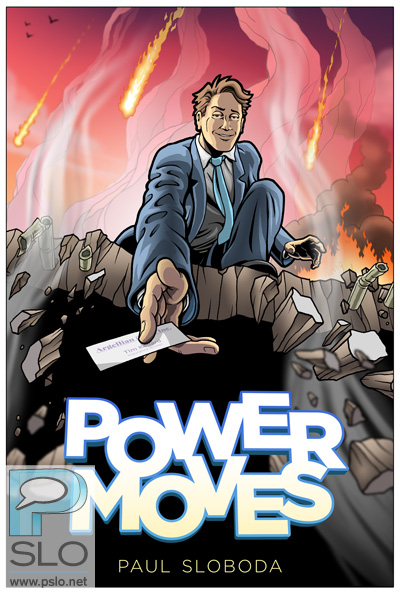
A new & unpublished cover to Power Moves #1
shari: HOW DID MOVING TO L.A. effect your career aspirations?
pslo: Well, I moved to L.A. to follow my girlfriend at the time, and while the relationship ended, I decided to stay. LA seemed like a great center for a lot of creative industries, which didn’t exactly hurt my 20-something self. My “career aspirations” also need some explaining. On the one hand, you could say that for over twenty years now I’ve been working as a “professional visual artist” in one of the following industries: animation, motion design, graphic design, and illustration. On the other hand, you could just as easily say that for over twenty years I’ve been wishing I could do comic books for a living, and falling quite short. I’ve always loved comics, but just so we’re clear, I’m really barely a part of them as a professional.
shari: WHAT LED YOU TO TRANSITION into video animation?
pslo: So, backing up to Vancouver, pre-L.A.: I graduated from a two-year graphic design program and worked for a few years for a few small Vancouver firms as a junior graphic designer. I didn’t care for the pressure of taking something to print, dealing with paper stocks and print runs and proofing, etc. I enjoyed the design process, but for anything past the screen, the only interest I had in print concerns was for black & white comics. Also, being in my 20s and just starting out, the corporate projects really put me to sleep. I really valued learning about typography—I’ve been lucky to mentor under a lot of talented individuals (something I really miss, as a freelancer) and at this point I learned plenty from a very kind and patient designer named Bruce Darby—but, ultimately, the only graphic design jobs I found available at the time weren’t particularly exciting.
To learn how this leads me to video animation, turn to Question #9 and read about International Rocketship! If instead you’d like me to take the passageway into the creepy subterranean cavern, turn to Question #8 and read about Salvager Kain!
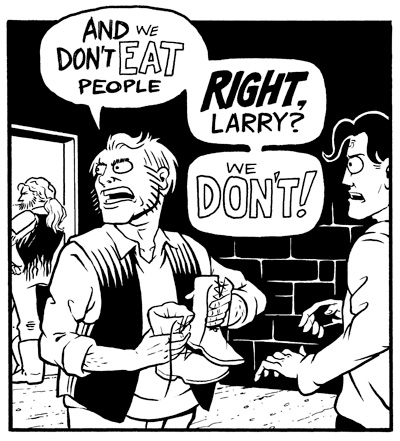
A panel from Salvager Kain #1.
shari: WHAT’S YOUR FAVORITE MEDIUM? The one you couldn’t live without?
pslo: To create, it’d be comics: pen & ink on illustration board! And they’re probably also my favorite medium to enjoy as the audience… though I am a huge fan of the extended, complex, serial narratives from certain television shows, so in truth it’s probably a close tie. The difference is I only ever want to be a fan of television, whereas I definitely want to MAKE comics.
shari: WHAT CONTINUES TO DRIVE YOU TO CREATE?
pslo: Jealousy. Coffee. Passion. Inspiration. And all those potent emotions that come with being a Pisces, a Sloboda, or both.
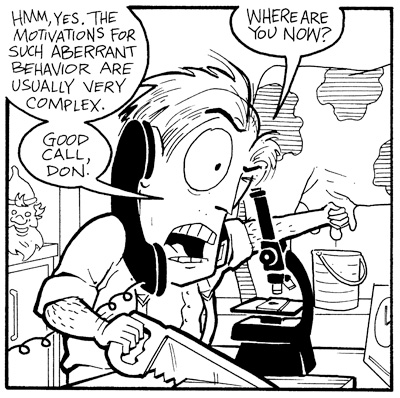
A panel from Odd Job Rod #1.
shari: TELL US ABOUT YOUR CREATIVE PROCESS. Does it differ from medium to medium?
pslo: Yes, for me the creative process differs greatly between animation and comics. For example, with animation, it’s usually motion graphics that I’m hired to do for a company where they’ve written the script and usually got some pre-existing designs to work with and stick to… so the creative limitations are pretty clear. At the start of the job I try to review a lot of current examples of great motion design and see what’s out there, the kind of quality I could to aspire to create, and in general what styles & details others have incorporated that I haven’t tried (or got in my head yet). I’m also trying to figure out what would be right look for the project and the client, but I think it’s good to seek out and look at a range of other stuff just to have it in your head. It’s probably the equivalent of going to artists’ shows or galleries or museums, the sort of thing I should do regularly as a professional, if I had more time. I just try to make time for it at the start of a gig. For comics, the process begins much more internally, usually when I’ve read or watched enough stories or had enough weird dreams or some other great insight and then I start making shitloads of notes for myself. Writing writing writing, and if I’m lucky it moves on to doodling and drawing. I say “if I’m lucky” because even though I have several comics stories I’ve drawn issues of (Exit At The Axis, Power Moves, Tales Of October, Salvager Kain) they’re far outnumbered by the story ideas that I haven’t started. To put it mildly, there are a lot of notes in my studio. They might not be worth the paper they’re written on, but they’re here, padding my walls.
shari: WHO ARE YOUR MAIN CREATIVE INFLUENCES?
pslo: It’s hard to pin this one down, since I feel like I’ve been influenced by so many different sources. Just music alone could get me rambling for hours. In terms of creative thinking and storytelling: in my 20s I got a lot of mileage from reading Edward DeBono’s books about thought, logic, and creative / lateral thinking. In my 30s I got more mileage out of Robert McKee’s how-to book “Story”. Even thought it’s about script writing, I think it applies quite well to comics and many other forms of storytelling.
I learned so much from my few years at Kwantlen College (before it became Kwantlen University, I guess), but especially from my teachers Rick Cuff and Ray Arnold, who did the heavy lifting to teach me what it means to think and behave as a professional in any career. Particular comics creators who’ve influenced me would be Dave Sim & Gerhard, Matt Wagner, Alan Moore, and Rich Burlew.
In (serial narrative) television, I’m drawn to dramas like Lost, Twin Peaks, The Wire, Breaking Bad, Deadwood, and comedies like Kids In The Hall, Community, Soap and WKRP in Cincinatti.
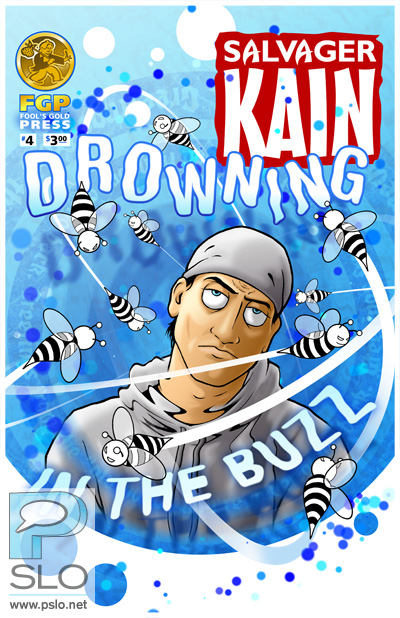
The cover to Salvager Kain #4.
shari: I FIND YOUR WORK INTRIGUING. PARTICULARLY SALVAGER KAIN. Tell us about him? What does he represent to you? I’ve secretly been guessing he’s the gritty less super-powery Superman to your Clark Kent?
pslo: Kain was my attempt to make my own complete fantasy world, but I think I forgot to include the fantasy. I started that story when my wife and I left Los Angeles for the midwest. The move was a positive one and I fully own my responsibility for taking that step, but all the same it did feel like I’d moved from the center of everything to the middle of nowhere. For a while I felt seriously disconnected from my professional life… and working as a freelancer for studios back in LA, I was concerned about the whole “out of sight, out of mind” thing… so when I had time to write, I let the extreme reaction of that alienation plot the trajectory of my new story. I came up with a character who’d been kicked out of the world they’d lived in, and forced to live on the outside. At the same time, I was also heavily inspired by the “Lost” tv series and loved the idea of how those people were removed from the world, relatively uninjured, and put someplace ostensibly familiar (looks just like Hawaii!) but completely—even supernaturally— unable to return to their lives… and they didn’t know why. The Kingdom and the Wall of Salvager Kain were partly inspired by that division of worlds, familiar but impenetrably distinct. Plus, you know, the amnesia. Because that’s believable. It seems like the most fun I had with the story was creating all the other characters: Nostromo Kabong, Snake, The Bees, The Softwear Pirates. More than any story I’d done prior, I could throw in whatever weird idea I had, so long as it connected to some deeper idea I wanted to add into the mix. There’s a monster in the second issue, a large bird-headed humanoid creature whose eggs can turn into gold if they’re too far from the nest, and it only speaks through reanimated pieces of dead humans—I think called “Sir Cultis San Jarabane”, because why not? Well, the whole idea for that character came out of some illustrations from the last book in C.S. Lewis’ Narnia Chronicles, “The Last Battle”; it was a demon called “Tash”, and even since I read that book as a kid I remember thinking that creature looked mighty sinister. Like everything I do, hopefully what I came up with veers far enough from the inspiration(s) to become its own thing. It’s unfortunate that I’ve pretty much declared this story dead, since I had high hopes for where to take Kain. Instead, he might just be exploring those underground caverns for the rest of eternity. At least he’s in for plenty of adventure, if not actual fame.
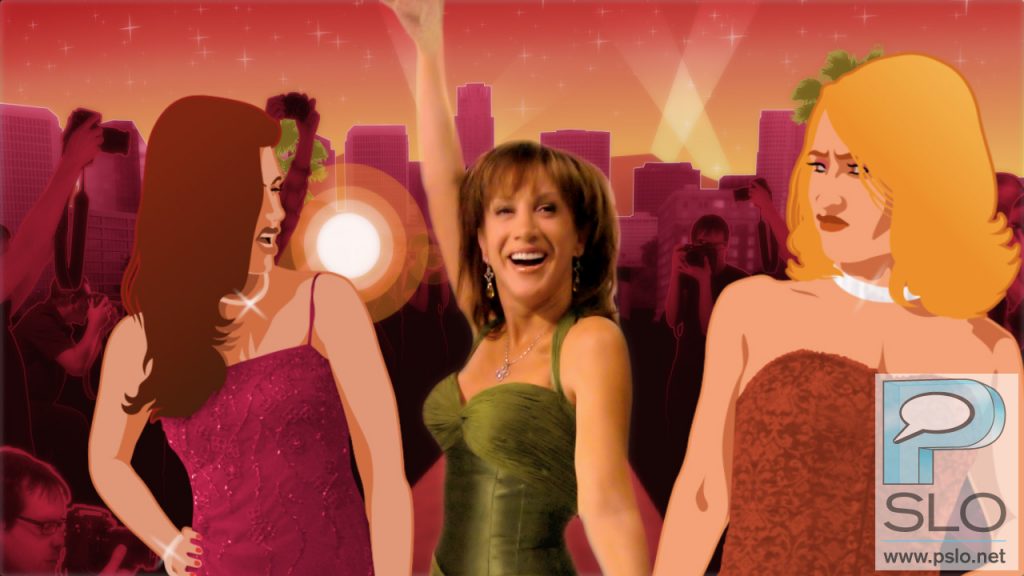
A still frame from the opening title animation Paul created for Kathy Griffin’s “My Life On The D-List”
shari: TELL US ABOUT YOUR FAVORITE PROJECT TO DATE …
pslo: I’ve been lucky enough to work on so many unique projects. Some were great fun to make; some were with great people, who I had the pleasure to meet and work alongside; some were just insanely unique, with the things that needed doing (like getting my wife to elbow Kathy Griffin, making the opening titles for her TV show). I don’t know if I could call it a favorite project, but one that certainly stands out was my first job at the first animation studio I worked for, the now-long-defunct International Rocketship Studios in Vancouver. That place was beautifully bizarre. When I was in college my interview with the studio ended with them telling me “you should come grab an empty desk here and start drawing, and if you’re really good we’ll either give you a job or beat the shit out of you”. It turns out I wasn’t, and never have been, a traditional drawing animator, but in 1994 they got the contract to create Gary Larson’s “Tales From The Far Side”, and I was hired on to the production staff, originally for cel painting but then moved on to inking and animation checking. Obviously this was back in the pre-computer-production days. I loved working in a studio with so many extremely creative (and dysfunctional) personalities, listening to loud music and drinking lethally strong coffee, but in particular I love that on one night near the end of production I was invited along to dinner with the producers and Gary Larson himself, who seemed shy but fascinating and he told a story about a long cruise gone seriously awry that I won’t repeat but treasure to this day.

“Sandie’s Castles”.
shari: WHO IS THE one person (or people) who supported you throughout your journey?
pslo: Beyond a doubt that would be my wife Stacey. My whole family, and like I’ve said particularly my mom, have been very supportive to me over the years… but there’s nothing like the day-to-day slog of trying to be an artist as an adult that makes you want and need to lean on someone for stability. Stacey has done so damn much for me and my art ever since we met, it’s beyond just her support & my thanks; she deserves a dozen trophies, a statue, a parade and a theme song by this point. I know I’m being silly with how I say it but she’s really just an incredible person who I have so much respect for, and I wish I could explain better how essential she has been for my career.
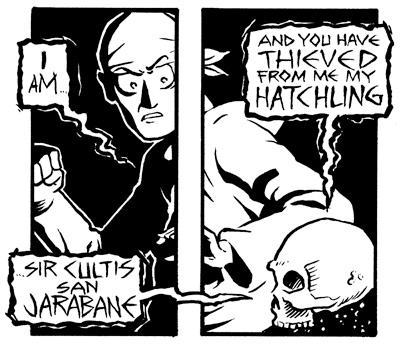
Two panels from Salvager Kain #2.
shari: TELL US A LITTLE (OR BIG) SOMETHING ABOUT YOU THAT NO ONE KNOWS. Where are those figurative (or literal but I wouldn’t recommend putting those in writing) bodies buried?
pslo: So much of my inspiration comes from the music I listen to. I’ve probably misheard lyrics from some song and been inspired to create whole characters or plot lines. I’m always putting on music, whether it’s when I’m working or driving or doing dishes or playing with my son. And that music is so incredibly important to me. I have an iPod Classic (a decade old now!) with a playlist full of mixed songs and videos, I call it “Radio Paul” and I just keep adding and subtracting tracks as I play through it (again for probably about a decade). I still find newer and (to me) more interesting music to get into, though it’s not always “current” music, it’s just as much an expansion of my musical education to seek out post-punk, jazz, surf rock, vaporwave, etc. And the sad thing is, as I’ve grown older & we live in an age where people have so many ways to customize their musical tastes (myself included), I wish I could share my music playlists with people to say “listen to this, isn’t this great? It makes me want to make this thing here!”… but I think my friends have pretty different tastes from me. Which brings up a second thing about me: I’m really not interested in participating in online message boards, to connect with a community of people I’ve never met, even if there are topics that I might only be able to enjoy with a handful of strangers in different places. That’s probably something I ought to change, but at the moment it just feels like a make-work task, and I’m better off spending that time on actual-work, creating something new on my own.
shari: WHAT’S YOUR ONE DREAM PROJECT or client and why?
pslo: My dream project is the same one I’ve had for most of my adult life: I wish I could create and tell a story that was entirely my own (not someone else’s characters) that I found creatively satisfying, that I could tell in regular installments to a decent-sized audience that could pay me even a part of a modest living. If I could commit entirely to just comics that might be possible, but since for one reason or another I’m financially dependent on motion graphics & animation, for now I’ll have to settle for the free time I can get to tell the stories I can. It’s not the ideal circumstances for my creative side, but it’s still a pretty darn lucky compromise.
Thanks again for the great interview Paul! Anyone wishing to view more of Paul’s work or to contact him can do so through the following websites:
In peace, love and art,

P.S. Adore this interview and need more? SIGN UP BELOW for more goodness and have interviews, decadently luxe art and frolicking unicorns sent directly to your inbox.
SPREAD THE LOVE



Trackbacks/Pingbacks